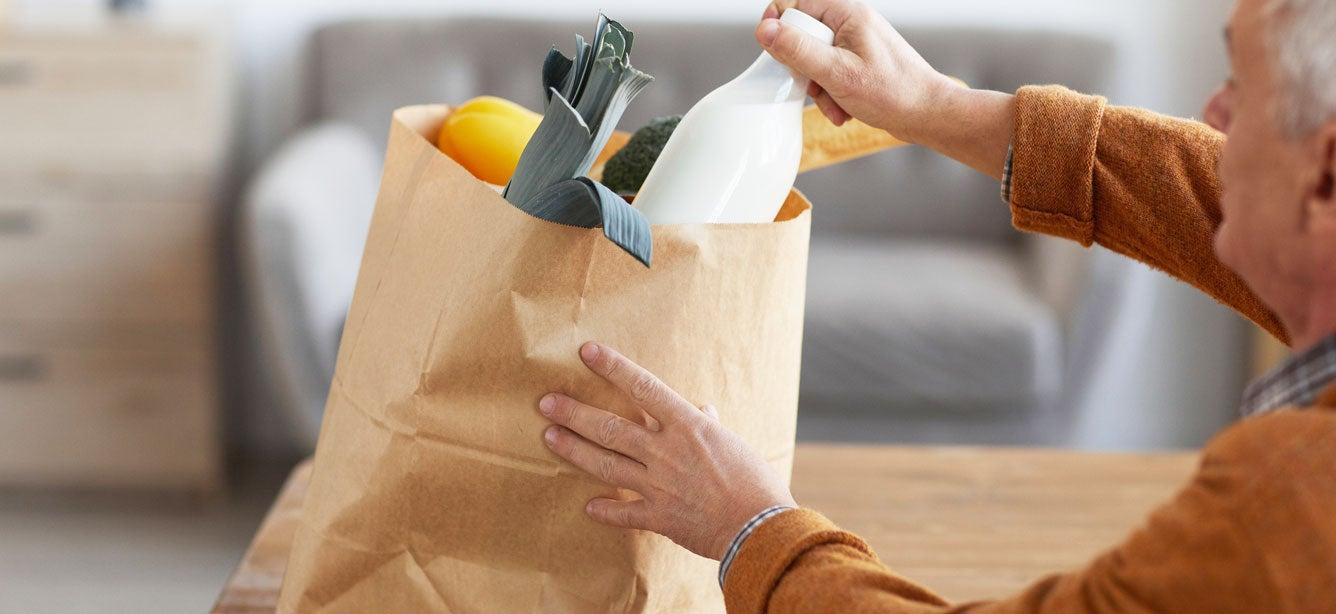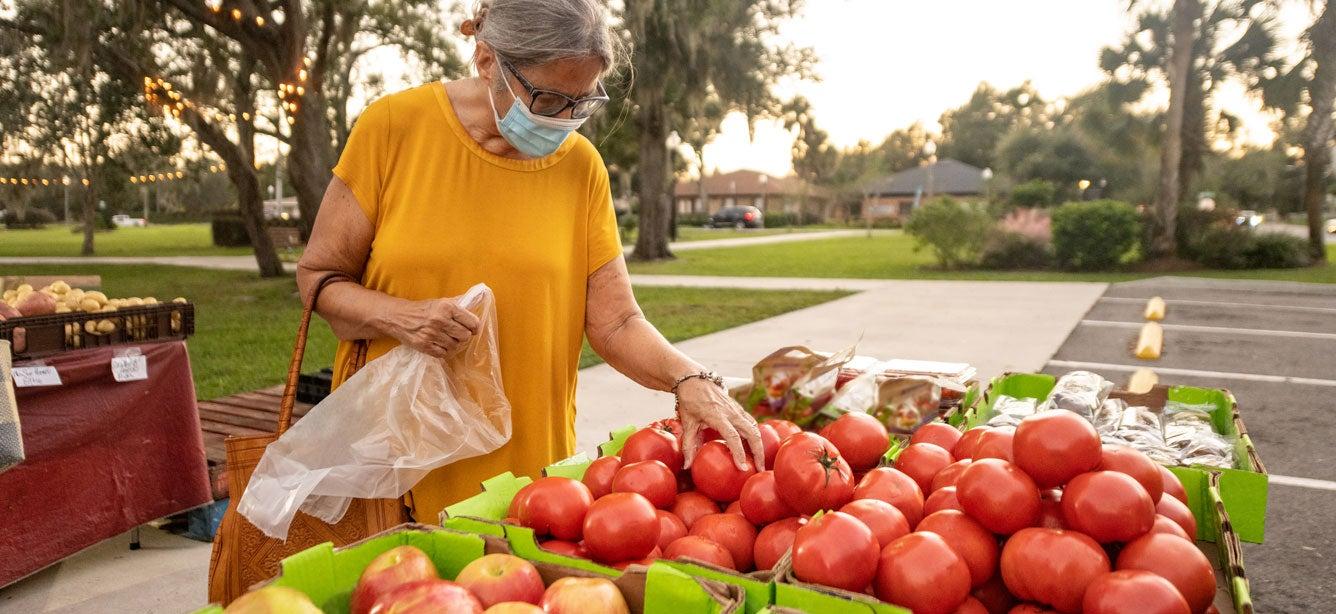
It can be challenging to eat a well-balanced diet on a limited budget—especially if you’re an older adult whose monthly income stays the same while food prices and other daily costs rise.
Are you in this situation? You’re not alone. In fact, as many as 1 in 14 seniors faces food insecurity (the inability to access enough quality food) in the U.S. today.1 In addition to malnutrition, this can lead to a constellation of challenges and spending tradeoffs that can negatively impact your health and quality of life.
According to Jen Teague, NCOA Associate Director for Health Coverage and Benefits, food insecurity affects older adults’ overall health in many ways.
“Food-insecure older adults are more likely to have falls because they have poor nutrition, which affects muscle mass, bone density, and balance. They also lack vital vitamins and minerals which puts them at risk for chronic diseases like diabetes,” she said.
Fortunately, government-funded initiatives such as the Supplemental Nutrition Assistance Program (SNAP) and the Seniors Farmers’ Market Nutrition Program (SFMNP) can help you afford your groceries and maintain good nutrition as you age. As with any assistance program, though, there can be limitations to your monthly benefits or the types of food you can buy.
The Commodity Supplemental Food Program (CSFP) can fill in some of those the gaps. Let’s take a look.
What is the Commodity Supplemental Food Program (CSFP)? And how does it help older adults?
Sometimes called the “Senior Food Box” program, the CSFP helps eligible participants improve their diets with nutritious surplus food from the U.S. Department of Agriculture's (USDA) commodity food list.
In fiscal year 2022, the CSFP served about 631,000 older adults with incomes at or below 130% of the federal poverty level (FPL).2 See poverty guidelines for 2024.
A typical monthly food package might include items such as:
- Milk
- Juice
- Cereal
- Rice or pasta
- Peanut butter
- Dry beans
- Canned meat, poultry, or fish
- Canned fruits and vegetables
Although the CSFP doesn’t provide a complete and balanced diet on its own, it can serve as a reliable source of nutrients that you otherwise might not get enough of. This is true even if you already participate in other food assistance programs. For instance, while $23 in minimum monthly SNAP benefits can go further than you may think, the extra groceries you receive in a senior food box—estimated by Feeding America as containing $50 worth of food—can help you prepare even more healthy meals.
How does the Commodity Supplemental Food Program operate?
Through the CSFP, the USDA Food and Nutrition Service (FNS) distributes government surplus food and administrative funding to participating states. These states then partner with local public and nonprofit agencies to store and distribute the food.
In real life, this means that your state’s Department of Health, Department of Agriculture, or other agency works with your local food bank, senior center, community health center, or other partner(s) to qualify and enroll participants and distribute the food each month.

I’m interested in receiving a monthly Senior Food Box. What is the eligibility requirement?
At one time, the CSFP served women, infants, and children as well as older adults. Following a 2014 amendment to the Agriculture and Consumer Protection Act, however, the CSFP now exclusively serves low-income adults who are at least 60 years old.3 (Women, infants, and children who were certified prior to Feb. 6, 2014, may continue to receive benefits until they are no longer eligible under previous program rules.)
Each state sets household income limits for the program, which start at or below 130% of the federal poverty guidelines. Since the income limits depend on where you live, you will need to contact your local FNS agency for more information. Be sure to ask about a commodity supplemental food program application, too.
Although uncommon, some states may also impose residency requirements and proof that you are “at nutritional risk.”
Can I get a senior food box if I already receive SNAP assistance?
Yes. There are no rules prohibiting you from getting both. In fact, when combined with other benefit programs like SNAP and the Seniors Farmers’ Market Nutrition Program, the CSFP can help you better fill your refrigerator and pantry.
How do I find a Senior Food Box program near me?
The USDA authorizes all 50 states, the District of Columbia, Puerto Rico, and several Indian Tribal Organizations (ITO)s to operate the Commodity Supplemental Food Program—though not all of them do. Use the USDA’s contact map to check availability in your area.
Do you sometimes struggle to buy groceries? Are you concerned about your food security overall? NCOA is here to help. Learn more about the food assistance programs you may qualify for, and use our free, confidential BenefitsCheckUp tool to uncover additional financial resources. These benefits programs can help you pay for food, utilities, medicine, health care, and more. Visit BenefitsCheckUp.org today to get started.
Sources
1. Feeding America. The State of Senior Hunger in America in 2021. April 2023. Found on the internet at https://www.feedingamerica.org/research/senior-hunger-research/senior
2. U.S. Census Bureau. Income, Poverty and Health Insurance Coverage in the United States: 2022. Sept. 12, 2023. Found on the internet at https://www.census.gov/newsroom/press-releases/2023/income-poverty-health-insurance-coverage.html
2. Feeding America. Commodity Supplemental Food Program (CSFP). Found on the internet at https://feedingamericaaction.org/learn/issue-areas/commodity-supplemental-food-program
3. USDA Food and Nutrition Service. Applicant/Recipient. Commodity Supplemental Food Program. Found on the internet at https://www.fns.usda.gov/csfp/applicant-recipient



